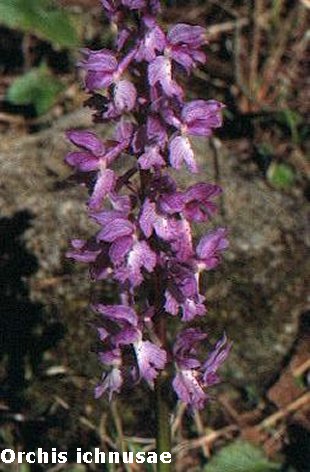|


Comments
to the offered plants:
Orchis militaris X anthropophorum.
Also known as a natural hybrid. Flowering is expected
not before spring 2004.
|
Distribution:
As defined by Pridgeon et al. 1997, there are only 32 species
left in the genus. The distribution is mainly euromediteranean,
from the Canary Islands to the Caucasus. Orchis militaris goes east
to Sibiria and Mongolia.
Description:
Flower stems 10 to 60cm high, with a rosette of leaves. Orchis
has small to medium sized, numerous flowers. A spur is always present
on the labellum. The perianth segments spread or form a hood. All
species are insect pollinating.
Culture:
Orchis are slightly more difficult to grow compared to Anacamptis.
For some species the active growing period is very short. All plants
are summer dormant and rest as tuberoids. Plants emerge in late
summer, autumn or late winter and flower in spring and early summer.
The leaves of Orchis militaris emerge in late March and the plants
go dormant at the end of June. Culture sunny or slightly shaded
for woodland species. Frost hardiness depends on the species. Frost
hardy up to -6°C (mediteranean species and races) or up to -18°C
(middle European species and races). Regular watering during the
growing period is essential for pot culture. Fertilize monthly with
0.2g/l until flowering. Reduce watering with the onset of flowers
and stop as the leaves die back. Completely dry during dormancy.
In outdoor culture, summer rain is not harmful if planted
in a well draining soil. Occasionally a light spray of water
for small plants and seedlings to prevent dehydration. If grown
inside, move plants temporary outside in late summer as cool
nights and some rain will stimulate plants into the new growing
season.
Recommended potting mixes:
80% fine to medium grade perlite gives good results. 20%
organic components. Favourable are fermented or N-impregnated
wood shavings or saw dust. (Toresa can be recommended.) 20% peatbased
mixes as TKS1 have given inferior results. Spagnum moss is
not suitable. Substrates have to be well draining with a pH
of about 6.
Further reading:
Orchids of Britain & Europe. Pierre Delforge, 1995. Collins
Photo Guide. ISBN 0 00 2200244.
Orchideen im Garten: Verwendung, Pflege und Vermehrung. Gerd
Kohls und Ulrich Kähler, 1993.Parey, ISBN 3 489 636244.
Orchideen für den Garten: Europäische und tropische Erdorchideen.
Alfons Bürger, 1992. Ulmer, ISBN 3 8001 64876.
Das Moor im eigenen Garten: Moorgärten anlegen,gestalten
und pflegen. Erich Maier, 2000. Parey, ISBN 3 8263 3301 2.
Hardy orchids. Phillip Cribb and Christopher Bailes, 1989.
Timber Pr. ISBN 0 88192 147 5.
Die Orchideen Mitteleuropas und der Alpen. Presser Helmut,
1995. ecomed, ISBN 3 609 65600 X.
|

